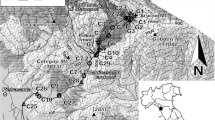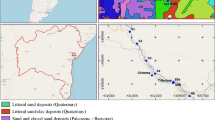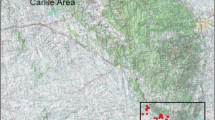Abstract
Purpose
Past metal mining has left a legacy of highly contaminated sediments representing a significant diffuse source of contamination to water bodies in the UK and worldwide. This paper presents the results of an integrated approach used to define the role of sediments in contributing to the dissolved lead (Pb) loading to surface water in a mining-impacted catchment.
Materials and methods
The Rookhope Burn catchment, northern England, UK is affected by historical mining and processing of lead ore. Quantitative geochemical loading determinations, measurements of interstitial water chemistry from the stream hyporheic zone and inundation tests of bank sediments were carried out.
Results and discussion
High concentrations of Pb in the sediments from the catchment, identified from the British Geological Survey Geochemical Baseline Survey of the Environment (GBASE) data, demonstrate both the impact of mineralisation and widespread historical mining. The results from stream water show that the stream Pb load increased in the lower part of the catchment, without any apparent or significant contribution of point sources of Pb to the stream. Relative to surface water, the interstitial water of the hyporheic zone contained high concentrations of dissolved Pb in the lower reaches of the Rookhope Burn catchment, downstream of a former mine washing plant. Concentrations of 56 μg l−1 of dissolved Pb in the interstitial water of the hyporheic zone may be a major cause of the deterioration of fish habitats in the stream and be regarded as a serious risk to the target of good ecological status as defined in the European Water Framework Directive. Inundation tests provide an indication that bank sediments have the potential to contribute dissolved Pb to surface water.
Conclusions
The determination of Pb in the interstitial water and in the inundation water, taken with water Pb mass balance and sediment Pb distribution maps at the catchment scale, implicate the contaminated sediments as a large Pb supply to surface water. Assessment of these diffuse contaminant sources is critical for the successful management of mining-impacted catchments.




Similar content being viewed by others
References
Balistrieri LS, Foster AL, Gough LP, Gray F, Rytuba JJ, Stillings LL (2007) Understanding metal pathways in mineralized ecosystems. USGS Circular 1317, 12 pages
Ball JW, Nordstrom DK (1991) User's manual for WATEQ4F, with revised thermodynamic data base and test cases for calculating speciation of major, trace, and redox elements in natural waters. USGS Open-File Report 91–183, 189 pages
Banks VJ, Palumbo-Roe B (2010) Synoptic monitoring as an approach to discriminating between point and diffuse source contributions to zinc loads in mining impacted catchments. J Environ Monit 12:1684–1698
Baresel C, Destouni G, Gren I (2006) The influence of metal source uncertainty on cost-effective allocation of mine water pollution abatement in catchments. J Environ Manage 78:138–148
Bencala KE (2011) Stream-groundwater interactions. In: Wilderer P (ed) Treatise on water science. Elsevier Science 2:537–546. doi:10.1016/B978-0-444-53199-5.00115-9
Bencala K, Kennedy VC, Zellweger GW, Jackman AP, Avanzino RJ (1984) Interactions of solutes and streambed sediment. 1. An experimental analysis of cation and anion transport in a mountain stream. Water Resour Res 20:1797–1803
Benner SG, Smart EW, Moore JN (1995) Metal behavior during surface-groundwater interaction, Silver Bow Creek, Montana. Environ Sci Technol 29:1789–1795
Butler BA (2009) Effect of pH, ionic strength, dissolved organic carbon, time, and particle size on metals release from mine drainage impacted streambed sediments. Water Res 43:1392–1402
Byrne P, Reid I, Wood PJ (2009) Short-term fluctuations in heavy metal concentrations during flood events through abandoned metal mines, with implications for aquatic ecology and mine water treatment. In: Proceedings of the International Mine Water Conference, 19–23 October 2009, Pretoria, South Africa, ISBN 978-0-09802623-5-3, 124-129
Byrne P, Reid I, Wood PJ (2010) Sediment geochemistry of streams draining abandoned lead/zinc mines in central Wales: the Afon Twymyn. J Soils Sediments 10:683–697
Caruso BS, Ward RC (1998) Assessment of nonpoint source pollution from inactive mines using a watershed-based approach. Environ Manag 22:225–243
Chapman BM, Jones DR, Jung RF (1983) Processes controlling metal ion attenuation in acid mine drainage streams. Geochim Cosmochim Acta 47:1957–1973
Coetser SE, Heath RG, Ndombe N (2007) Diffuse pollution associated with the mining sectors in South Africa: a first-order assessment. Water Sci Technol 55:9–16
Filipek L, Chao TT, Carpenter RH (1981) Factors affecting the partitioning of Cu, Zn and Pb in boulder coatings and stream sediments in the vicinity of a polymetallic sulfide deposit. Chem Geol 33:45–64
Gozzard E, Mayes WM, Potter HA, Jarvis AP (2011) Seasonal and spatial variation of diffuse (non-point) source zinc pollution in a historically metal mined river catchment, UK. Environ Pollut 159:3113–3122
Harvey JW, Fuller CC (1998) Effect of enhanced manganese oxidation in the hyporheic zone on basin-scale geochemical mass balance. Water Resour Res 3:623–636
Hudson-Edwards KA, Macklin MG, Curtis CD, Vaughan DJ (1996) Processes of formation and distribution of Pb-, Zn-, Cd- and Cu-bearing minerals in the Tyne basin, northeast England: implications for metal contaminated river systems. Environ Sci Technol 30:72–80
Hudson-Edwards KA, Macklin MG, Brewer PA, Dennis IA (2008) Assessment of metal mining-contaminated river sediments in England and Wales. EA Sci Report SC030136/SR4
Johnson K, Younger PL (2002) Hydrogeological and geochemical consequences of the abandonment of Frazer's Grove carbonate hosted Pb/Zn fluorspar Mine, North Pennines, U.K. In: Younger PL, Robins NS (eds) Mine water hydrogeology and geochemistry. Geol Soc London Special Pub 198:347–363
Johnson CC, Breward N, Ander EL, Ault L (2005) G-BASE: baseline geochemical mapping of Great Britain and Northern Ireland. Geochem Explor Environ A 5:347–357
Kimball BA, Runkel RL, Walton-Day K, Bencala KE (2002) Assessment of metal loads in watersheds affected by acid mine drainage using tracer injection and synoptic sampling: Cement Creek, Colorado, USA. Appl Geochem 17:1183–1207
Macklin MG, Dowsett RB (1989) The chemical and physical speciation of trace metals in fine grained overbank flood sediments in the Tyne basin, north-east England. Catena 16:135–151
Macklin MG, Brewer PA, Hudson-Edwards KA, Bird G, Coulthard TJ, Dennis IA, Lechler PJ, Miller JR, Turner JN (2006) A geomorphological approach to the management of rivers contaminated by metal mining. Geomorphology 79:423–447
Mayes WM, Gozzard E, Potter HAB, Jarvis AP (2008) Quantifying the importance of diffuse minewater pollution in a historically heavily coal mined catchment. Environ Poll 151:165–175
Mayes WM, Johnston D, Potter HAB, Jarvis AP (2009) A national strategy for identification, prioritisation and management of pollution from abandoned non-coal mine sites in England and Wales. I. Methodology development and initial results. Sci Total Environ 407:5435–5447
Mighanetara K, Braungardt CB, Rieuwerts JS, Azizi F (2009) Contaminant fluxes from point and diffuse sources from abandoned mines in the River Tamar catchment, UK. J Geochem Explor 100:116–124
Palumbo-Roe B, Banks V, Chenery S, Weiss D (2010) Tracing sources and fate of zinc in a mining-impacted river catchment: insights from flow measurements, synoptic sampling and zinc isotopes. In: Wolkersdorfer Ch, Freund A (eds) Mine water and innovative thinking. Nova Scotia (CBU Press), Sydney, pp 383–387
Parkhurst DL, Appelo CAJ (1999) User's Guide to PHREEQC—(Version 2) a computer program for speciation, batch-reaction, one-dimensional transport, and inverse geochemical calculations: U.S. Geological Survey Water—Resources Investigations Report 99–4259, p312
Pulford ID, MacKenzie AB, Donatello S, Hastings L (2009) Source term characterisation using concentration trends and geochemical associations of Pb and Zn in river sediments in the vicinity of a disused mine site: implications for contaminant metal dispersion processes. Environ Poll 157:1649–1656
Warburton J, Danks K, Wishart D (2003) Stability of an upland gravel-bed stream, Swinhope Burn, Northern England. Catena 49:309–329
Acknowledgments
The authors would like to thank Ben Klinck and Simon Chenery for help with the sampling and analysis. This work was funded by the Natural Environment Research Council (NERC) and the paper published with the permission of the Executive Director of the British Geological Survey (NERC).
Author information
Authors and Affiliations
Corresponding author
Additional information
Responsible editor: Geraldene Wharton
Electronic supplementary material
Below is the link to the electronic supplementary material.
ESM. 1
(DOCX 25.3 kb)
Rights and permissions
About this article
Cite this article
Palumbo-Roe, B., Wragg, J. & Banks, V.J. Lead mobilisation in the hyporheic zone and river bank sediments of a contaminated stream: contribution to diffuse pollution. J Soils Sediments 12, 1633–1640 (2012). https://doi.org/10.1007/s11368-012-0552-7
Received:
Accepted:
Published:
Issue Date:
DOI: https://doi.org/10.1007/s11368-012-0552-7




